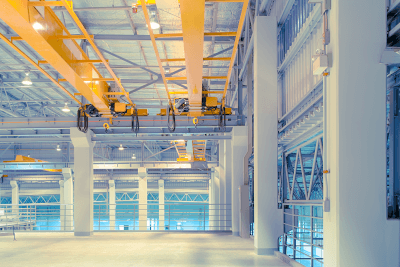What Is a Traveling Crane?

Traveling cranes are cranes for lifting and unloading that are installed on the ceiling of buildings such as warehouses.
A runway is a structure with beams and rails on which the crane can travel. Traveling cranes are equipment that carry suspended loads while traveling along this runway. Traveling cranes are usually installed along both side walls of a building.
Traveling cranes are capable of three movements: traveling, traversing, and hoisting. This makes it possible to move the crane hook three-dimensionally, enabling the crane to move suspended loads anywhere in the building.
Uses of Traveling Cranes
Traveling cranes are used in all kinds of industrial and commercial applications. Specific applications include the following:
- For lifting and unloading in automated warehouses and large warehouses
- Maintenance of large equipment such as turbines and generators
- For loading and unloading products at electrodeposition plating plants
- For loading and unloading intermediate products in metal refining plants
Principle of Traveling Cranes
Traveling cranes consist of a power feeder, girder, saddle, trolley, power unit, and wire hook block.
1. Power Feeder
Traveling cranes are mostly powered by electricity. Power feeders that supply electricity to moving traveling cranes are mainly curtain cables or pantographs. A curtain cable is a cable that hangs down like a curtain.
The relay point is supported by a pulley, and the pulley runs and absorbs expansion and contraction as the crane travels. It is used in small-scale cranes with short travel distances and small lifting loads.
A pantograph consists of a sliding stone and a spring, and electricity is supplied when the sliding stone makes contact with a conductor to which voltage is applied. It is applied to traveling cranes and large cranes that move at high speeds.
2. Girder
A girder is a structure that supports the entire crane. Since it is subjected to the load of the suspended load, it must be strong enough to withstand the maximum load. Therefore, the girder is designed to have the optimum shape and structure according to the length and load.
Simple traveling cranes use I-shaped steel, and as the lifting load becomes heavier, they are reinforced with angle or truss structures.
3. Saddle
The saddle is the driving part to which the wheels are attached for traveling on the runway. Wheels strong enough to support the girder are selected.
Depending on the runway structure, saddles are manufactured in a shape that hangs from the I-beam or runs on rails. If there is a risk of contact with walls or other surfaces at the end of the runway, cushioning material or the like is attached.
4. Trolley
A trolley is a cart that traverses on the girder together with hook blocks and wires. The structure differs depending on the type of traveling cranes, and some traveling cranes have a driver’s seat attached to the trolley.
5. Power Unit
The power unit is the power unit that allows the crane to operate. Most traveling cranes consist of a motor and a reduction gear. For motors, wire-wound motors are used for variable speed operation. In recent years, a combination of an inverter and a cage-type induction motor is commonly used.
The power required for the power unit increases in the order of hoisting, traveling, and traversing. The hoisting power unit lifts the load by hoisting a steel wire or hook block. The hoisting power unit is equipped with a brake to prevent the load from falling under its own weight. Smaller traveling cranes may use a human-powered chain block as the traversing/traveling drive unit.
Types of Traveling Cranes
Traveling cranes are divided into several types according to their construction.
1. Hoist Traveling Cranes
Traveling cranes use a hoist as the hoisting device. Since an off-the-shelf hoist can be used, the crane can be installed at a low cost. Traveling cranes are used as relatively small overhead cranes.
2. Club Trolley Type Traveling Cranes
Traveling cranes using a club trolley with hoisting and traversing devices. This type of crane is used for larger cranes than the hoist type. They are characterized by their robustness and ease of maintenance. However, they are more expensive than hoist-type cranes because they are individually designed according to the installation space and required capacity.
3. Rope Trolley Type Traveling Cranes
Traveling cranes are rope-driven overhead cranes with a trolley that does not have a traversing or hoisting device. The trolley itself is simple to build, so the overall crane weight can be reduced. However, it has the disadvantage of rapid deterioration over time due to rope wear.